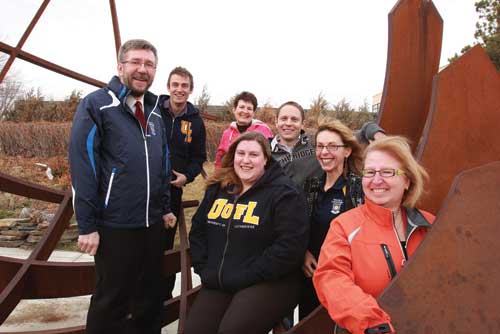There's no doubt you've heard the buzz about a student portal or seen the campus-wide campaign about a U of L learning commons and study centre, while just recently the University broke ground on another student residence.
If there are common threads to these initiatives, it's that they embody the student-centred ideal that is embedded within the University's Strategic Plan; an ideal that is articulated in part by the activities of the Recruitment & Retention Integrated Planning (RRIP) team.
In 2009, in response to a dramatic shortfall in student application numbers, a University wide Strategic Enrolment Management (SEM) program was formed to create a competitive advantage in recruitment by collaborating and sharing resources across campus.

"It was designed as a vehicle that would pull the faculties together to support and have a more structured approach to recruitment techniques," says Vice-President (Academic) and Provost Dr. Andy Hakin.
Recognizing that getting students in the door was only half the solution however, Hakin began thinking about how the institution could keep its new students. RRIP was subsequently created to compliment the work of SEM and to drive student retention initiatives.
"RRIP basically looks at how we need to support our students once SEM has done its work in bringing students to the U of L," says Hakin. "They ask the basic questions about the student experience, about how students get into the institution and what supports students use when they are here."
Karen Clearwater, the lead on the RRIP team, brought members of the University community together from a number of different areas of the institution.
"We did not necessarily want all unit managers, we looked at those people that work directly with students on a day-to-day basis or that have been directly involved in providing services to students," says Clearwater.
The team includes faculty members, APO's and AUPE membership and all have been very dedicated to the RRIP project. The team started its work with focus groups and unit presentations, as well as an environmental scan.
"We collected information from as many sources as we could," says Clearwater.
From the information compiled, certain subject themes took on greater priority than others. It was at that point Subject Matter Teams (SMT) were established. Currently 85 faculty, staff and students are working toward the completion of priority projects. Student leaders on campus have played a critical role in these SMTs.
"The whole process has taken a lot of time and we are pleased to see the results coming forward with some great initiatives," says Clearwater.
Student retention rates have long been an issue for the University, and the RRIP initiatives have been aimed directly at improving those numbers.
"The idea is that we have to change what we are doing in respect to the student experience, with the overall goal of reducing that attrition number," says Hakin. "But no success will be possible without maintaining the high quality of our academic programs."
Four major projects are currently in the works, all having been identified as priorities by RRIP. They include the establishment of a student portal, the move from paper to electronic applications for graduate studies, the establishment of a 24-hour study centre with a more robust tutoring and mentor service and the creation of an academic success centre which will house a number of student services. As well, the push for more student housing came through RRIP recommendations, something that will be realized with the construction of Aperture Park Phase 3.
"That was another major piece that came forward from that group," says Hakin. "They identified that we needed more residence spaces, and the University
responded to that because we know that students who are supported in a student housing environment perform better and have a substantially improved retention rate."
Both SEM and RRIP are seen as ongoing initiatives.
"It's a continuous improvement vehicle," says Hakin. "It cannot be one or two projects and we're done, things need to keep improving in terms of how we support our students, how we interact with them and how we improve their academic experience at our University.
GET THE FACTS
· For more information on the RRIP project, check out the website www.uleth.ca/recruitment-retention
· The RRIP team was established in 2010
· In addition to team sponsors Andy Hakin and Nancy Walker and project manager Karen Clearwater, the 10-person team consists of co-ordinator Heather Mirau, Steve Brodrick, Trevor Flexhaug, Dan Kazakoff, Carma Leishman, Nicole Leusink, Heidi MacDonald, Alice Miller, Chris Roberts and Barbara Williams
This story first appeared in the December 2011 issue of the Legend. If you'd like to see the full issue in a flipbook format, follow this link.
